Ryo Fujii
Human Preference-Aligned Concept Customization Benchmark via Decomposed Evaluation
Sep 03, 2025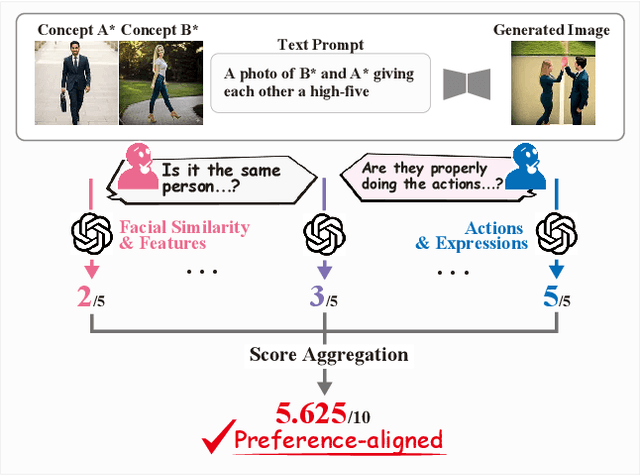

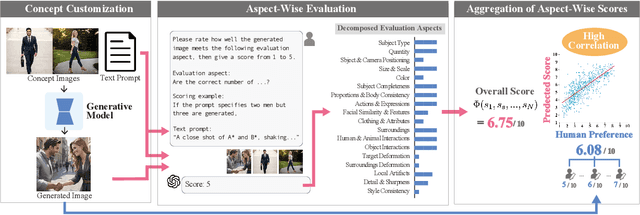

Abstract:Evaluating concept customization is challenging, as it requires a comprehensive assessment of fidelity to generative prompts and concept images. Moreover, evaluating multiple concepts is considerably more difficult than evaluating a single concept, as it demands detailed assessment not only for each individual concept but also for the interactions among concepts. While humans can intuitively assess generated images, existing metrics often provide either overly narrow or overly generalized evaluations, resulting in misalignment with human preference. To address this, we propose Decomposed GPT Score (D-GPTScore), a novel human-aligned evaluation method that decomposes evaluation criteria into finer aspects and incorporates aspect-wise assessments using Multimodal Large Language Model (MLLM). Additionally, we release Human Preference-Aligned Concept Customization Benchmark (CC-AlignBench), a benchmark dataset containing both single- and multi-concept tasks, enabling stage-wise evaluation across a wide difficulty range -- from individual actions to multi-person interactions. Our method significantly outperforms existing approaches on this benchmark, exhibiting higher correlation with human preferences. This work establishes a new standard for evaluating concept customization and highlights key challenges for future research. The benchmark and associated materials are available at https://github.com/ReinaIshikawa/D-GPTScore.
EgoSurgery-HTS: A Dataset for Egocentric Hand-Tool Segmentation in Open Surgery Videos
Mar 24, 2025
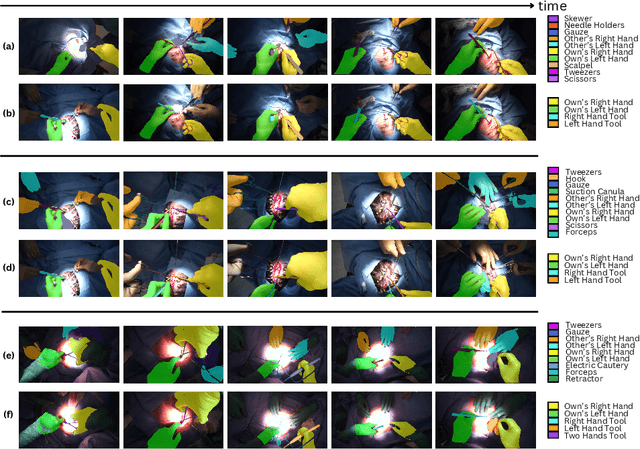


Abstract:Egocentric open-surgery videos capture rich, fine-grained details essential for accurately modeling surgical procedures and human behavior in the operating room. A detailed, pixel-level understanding of hands and surgical tools is crucial for interpreting a surgeon's actions and intentions. We introduce EgoSurgery-HTS, a new dataset with pixel-wise annotations and a benchmark suite for segmenting surgical tools, hands, and interacting tools in egocentric open-surgery videos. Specifically, we provide a labeled dataset for (1) tool instance segmentation of 14 distinct surgical tools, (2) hand instance segmentation, and (3) hand-tool segmentation to label hands and the tools they manipulate. Using EgoSurgery-HTS, we conduct extensive evaluations of state-of-the-art segmentation methods and demonstrate significant improvements in the accuracy of hand and hand-tool segmentation in egocentric open-surgery videos compared to existing datasets. The dataset will be released at https://github.com/Fujiry0/EgoSurgery.
RealTraj: Towards Real-World Pedestrian Trajectory Forecasting
Nov 26, 2024



Abstract:This paper jointly addresses three key limitations in conventional pedestrian trajectory forecasting: pedestrian perception errors, real-world data collection costs, and person ID annotation costs. We propose a novel framework, RealTraj, that enhances the real-world applicability of trajectory forecasting. Our approach includes two training phases--self-supervised pretraining on synthetic data and weakly-supervised fine-tuning with limited real-world data--to minimize data collection efforts. To improve robustness to real-world errors, we focus on both model design and training objectives. Specifically, we present Det2TrajFormer, a trajectory forecasting model that remains invariant in tracking noise by using past detections as inputs. Additionally, we pretrain the model using multiple pretext tasks, which enhance robustness and improve forecasting performance based solely on detection data. Unlike previous trajectory forecasting methods, our approach fine-tunes the model using only ground-truth detections, significantly reducing the need for costly person ID annotations. In the experiments, we comprehensively verify the effectiveness of the proposed method against the limitations, and the method outperforms state-of-the-art trajectory forecasting methods on multiple datasets.
CrowdMAC: Masked Crowd Density Completion for Robust Crowd Density Forecasting
Jul 20, 2024
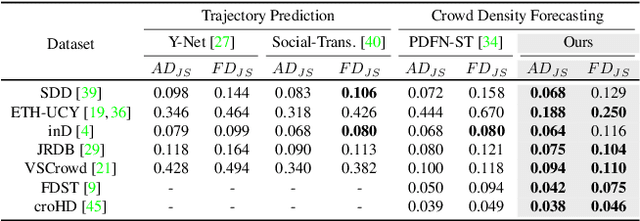
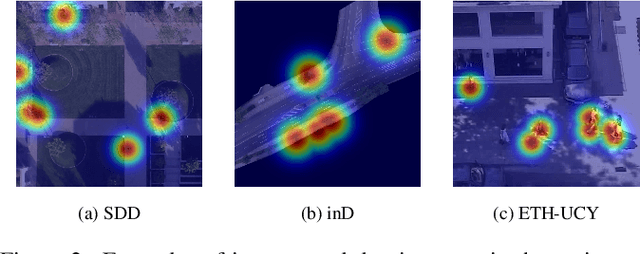

Abstract:A crowd density forecasting task aims to predict how the crowd density map will change in the future from observed past crowd density maps. However, the past crowd density maps are often incomplete due to the miss-detection of pedestrians, and it is crucial to develop a robust crowd density forecasting model against the miss-detection. This paper presents a MAsked crowd density Completion framework for crowd density forecasting (CrowdMAC), which is simultaneously trained to forecast future crowd density maps from partially masked past crowd density maps (i.e., forecasting maps from past maps with miss-detection) while reconstructing the masked observation maps (i.e., imputing past maps with miss-detection). Additionally, we propose Temporal-Density-aware Masking (TDM), which non-uniformly masks tokens in the observed crowd density map, considering the sparsity of the crowd density maps and the informativeness of the subsequent frames for the forecasting task. Moreover, we introduce multi-task masking to enhance training efficiency. In the experiments, CrowdMAC achieves state-of-the-art performance on seven large-scale datasets, including SDD, ETH-UCY, inD, JRDB, VSCrowd, FDST, and croHD. We also demonstrate the robustness of the proposed method against both synthetic and realistic miss-detections.
EgoSurgery-Tool: A Dataset of Surgical Tool and Hand Detection from Egocentric Open Surgery Videos
Jun 06, 2024Abstract:Surgical tool detection is a fundamental task for understanding egocentric open surgery videos. However, detecting surgical tools presents significant challenges due to their highly imbalanced class distribution, similar shapes and similar textures, and heavy occlusion. The lack of a comprehensive large-scale dataset compounds these challenges. In this paper, we introduce EgoSurgery-Tool, an extension of the existing EgoSurgery-Phase dataset, which contains real open surgery videos captured using an egocentric camera attached to the surgeon's head, along with phase annotations. EgoSurgery-Tool has been densely annotated with surgical tools and comprises over 49K surgical tool bounding boxes across 15 categories, constituting a large-scale surgical tool detection dataset. EgoSurgery-Tool also provides annotations for hand detection with over 46K hand-bounding boxes, capturing hand-object interactions that are crucial for understanding activities in egocentric open surgery. EgoSurgery-Tool is superior to existing datasets due to its larger scale, greater variety of surgical tools, more annotations, and denser scenes. We conduct a comprehensive analysis of EgoSurgery-Tool using nine popular object detectors to assess their effectiveness in both surgical tool and hand detection. The dataset will be released at https://github.com/Fujiry0/EgoSurgery.
Multimodal Cross-Domain Few-Shot Learning for Egocentric Action Recognition
May 31, 2024Abstract:We address a novel cross-domain few-shot learning task (CD-FSL) with multimodal input and unlabeled target data for egocentric action recognition. This paper simultaneously tackles two critical challenges associated with egocentric action recognition in CD-FSL settings: (1) the extreme domain gap in egocentric videos (\eg, daily life vs. industrial domain) and (2) the computational cost for real-world applications. We propose MM-CDFSL, a domain-adaptive and computationally efficient approach designed to enhance adaptability to the target domain and improve inference speed. To address the first challenge, we propose the incorporation of multimodal distillation into the student RGB model using teacher models. Each teacher model is trained independently on source and target data for its respective modality. Leveraging only unlabeled target data during multimodal distillation enhances the student model's adaptability to the target domain. We further introduce ensemble masked inference, a technique that reduces the number of input tokens through masking. In this approach, ensemble prediction mitigates the performance degradation caused by masking, effectively addressing the second issue. Our approach outperformed the state-of-the-art CD-FSL approaches with a substantial margin on multiple egocentric datasets, improving by an average of 6.12/6.10 points for 1-shot/5-shot settings while achieving $2.2$ times faster inference speed. Project page: https://masashi-hatano.github.io/MM-CDFSL/
EgoSurgery-Phase: A Dataset of Surgical Phase Recognition from Egocentric Open Surgery Videos
May 30, 2024Abstract:Surgical phase recognition has gained significant attention due to its potential to offer solutions to numerous demands of the modern operating room. However, most existing methods concentrate on minimally invasive surgery (MIS), leaving surgical phase recognition for open surgery understudied. This discrepancy is primarily attributed to the scarcity of publicly available open surgery video datasets for surgical phase recognition. To address this issue, we introduce a new egocentric open surgery video dataset for phase recognition, named EgoSurgery-Phase. This dataset comprises 15 hours of real open surgery videos spanning 9 distinct surgical phases all captured using an egocentric camera attached to the surgeon's head. In addition to video, the EgoSurgery-Phase offers eye gaze. As far as we know, it is the first real open surgery video dataset for surgical phase recognition publicly available. Furthermore, inspired by the notable success of masked autoencoders (MAEs) in video understanding tasks (e.g., action recognition), we propose a gaze-guided masked autoencoder (GGMAE). Considering the regions where surgeons' gaze focuses are often critical for surgical phase recognition (e.g., surgical field), in our GGMAE, the gaze information acts as an empirical semantic richness prior to guiding the masking process, promoting better attention to semantically rich spatial regions. GGMAE significantly improves the previous state-of-the-art recognition method (6.4% in Jaccard) and the masked autoencoder-based method (3.1% in Jaccard) on EgoSurgery-Phase. The dataset will be released at https://github.com/Fujiry0/EgoSurgery.
Weakly Semi-supervised Tool Detection in Minimally Invasive Surgery Videos
Jan 08, 2024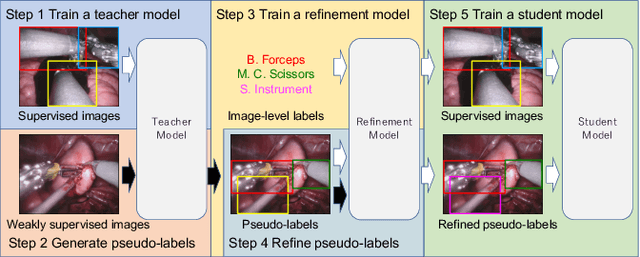

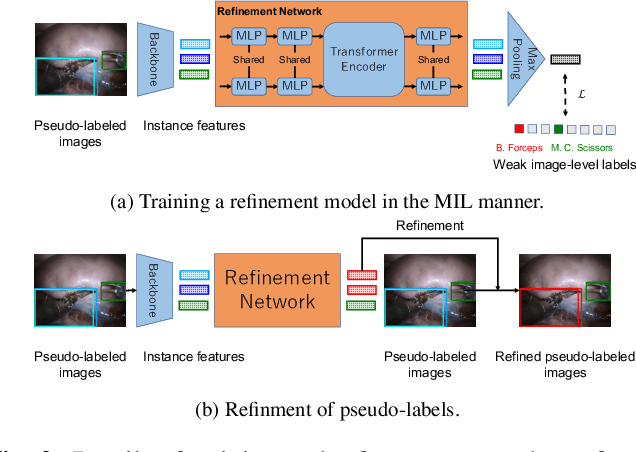

Abstract:Surgical tool detection is essential for analyzing and evaluating minimally invasive surgery videos. Current approaches are mostly based on supervised methods that require large, fully instance-level labels (i.e., bounding boxes). However, large image datasets with instance-level labels are often limited because of the burden of annotation. Thus, surgical tool detection is important when providing image-level labels instead of instance-level labels since image-level annotations are considerably more time-efficient than instance-level annotations. In this work, we propose to strike a balance between the extremely costly annotation burden and detection performance. We further propose a co-occurrence loss, which considers a characteristic that some tool pairs often co-occur together in an image to leverage image-level labels. Encapsulating the knowledge of co-occurrence using the co-occurrence loss helps to overcome the difficulty in classification that originates from the fact that some tools have similar shapes and textures. Extensive experiments conducted on the Endovis2018 dataset in various data settings show the effectiveness of our method.
Surgical tool classification and localization: results and methods from the MICCAI 2022 SurgToolLoc challenge
May 11, 2023



Abstract:The ability to automatically detect and track surgical instruments in endoscopic videos can enable transformational interventions. Assessing surgical performance and efficiency, identifying skilled tool use and choreography, and planning operational and logistical aspects of OR resources are just a few of the applications that could benefit. Unfortunately, obtaining the annotations needed to train machine learning models to identify and localize surgical tools is a difficult task. Annotating bounding boxes frame-by-frame is tedious and time-consuming, yet large amounts of data with a wide variety of surgical tools and surgeries must be captured for robust training. Moreover, ongoing annotator training is needed to stay up to date with surgical instrument innovation. In robotic-assisted surgery, however, potentially informative data like timestamps of instrument installation and removal can be programmatically harvested. The ability to rely on tool installation data alone would significantly reduce the workload to train robust tool-tracking models. With this motivation in mind we invited the surgical data science community to participate in the challenge, SurgToolLoc 2022. The goal was to leverage tool presence data as weak labels for machine learning models trained to detect tools and localize them in video frames with bounding boxes. We present the results of this challenge along with many of the team's efforts. We conclude by discussing these results in the broader context of machine learning and surgical data science. The training data used for this challenge consisting of 24,695 video clips with tool presence labels is also being released publicly and can be accessed at https://console.cloud.google.com/storage/browser/isi-surgtoolloc-2022.
Toward Unsupervised 3D Point Cloud Anomaly Detection using Variational Autoencoder
Apr 07, 2023Abstract:In this paper, we present an end-to-end unsupervised anomaly detection framework for 3D point clouds. To the best of our knowledge, this is the first work to tackle the anomaly detection task on a general object represented by a 3D point cloud. We propose a deep variational autoencoder-based unsupervised anomaly detection network adapted to the 3D point cloud and an anomaly score specifically for 3D point clouds. To verify the effectiveness of the model, we conducted extensive experiments on the ShapeNet dataset. Through quantitative and qualitative evaluation, we demonstrate that the proposed method outperforms the baseline method. Our code is available at https://github.com/llien30/point_cloud_anomaly_detection.
 Add to Chrome
Add to Chrome Add to Firefox
Add to Firefox Add to Edge
Add to Edge